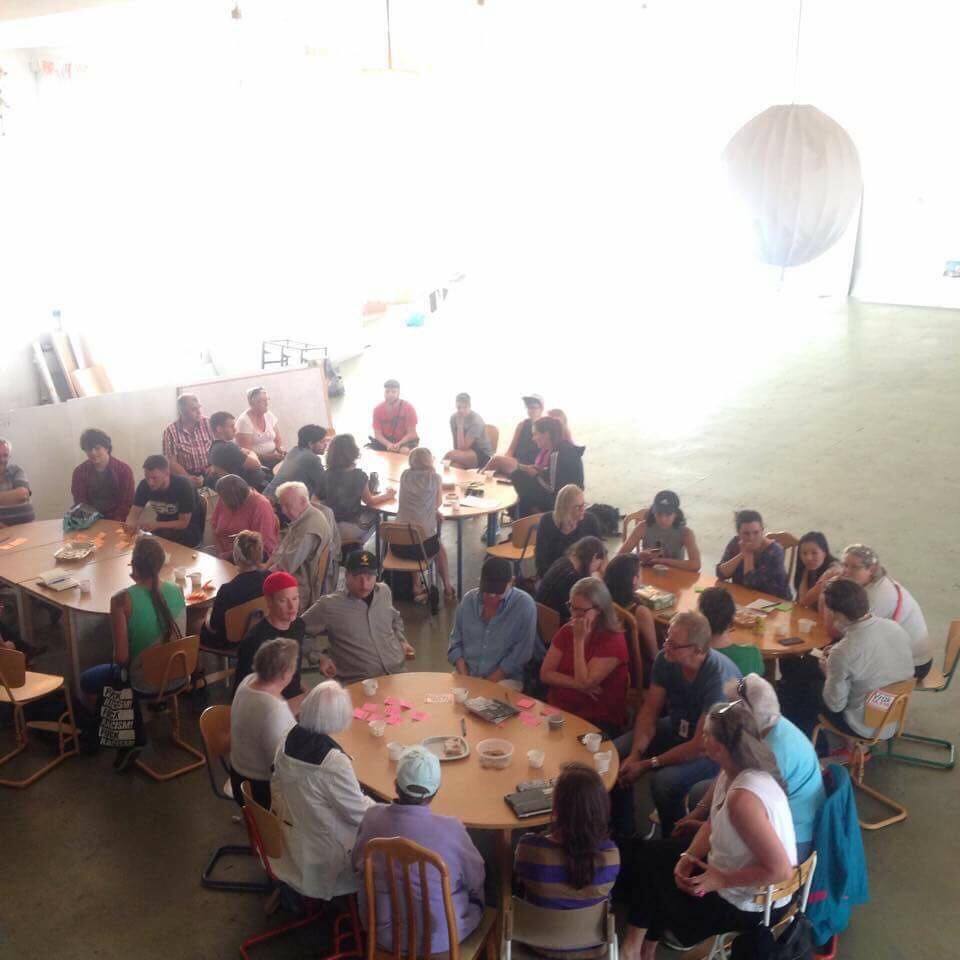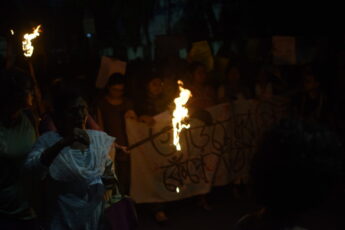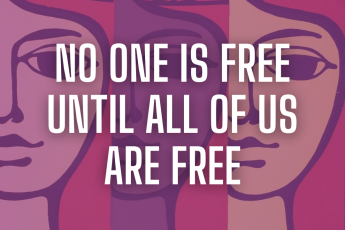
This week Conflict Corner gives voice to the struggle for housing and welfare rights in Sweden. Hagsätra, a neighbourhood at the southern periphery of Stockholm, is undergoing a process of privatization brought forward by the multinational corporation Ikea, which is responsible for a housing speculation especially at the expenses of hundreds of working class and migrant households. Hand in glove with municipal institutions, Ikea is enacting a policy of evictions on the ground of a planned renovation, so called “renovictions”, which aim at raising the rent and are particularly harmful in a context of a general precarization that Ikea is fostering since years. Moreover, cuts in social expenses and the monetization of welfare made this housing speculation a question of immediate survival, affecting the social reproduction of migrants and precarious workers. By putting on the table the experience of the occupied public auditorium, which became a space of communication among very diverse subjects, this article focuses on a very local and circumscribed – although necessary and urgent – practice of resistance that can nonetheless raise the overall question of how to organize against impoverishment and precarity, and how to do it effectively against the transnational chains of exploitation.
In recent years, the southern suburbs of Stockholm have been the setting of igniting sparks within the “right to the city” movement in Sweden. The interest for many of us involved, has not been to win approval for activities that we do. We have tried to engage, rather, in activities that provide better possibilities, for anybody living in the area, to connect with each other and strategise against the property owners. We can observe definite progression and certain victories – as well as what some might call popular radicalization (or, more favourably: increased class consciousness). But this report is in equal parts a projection: from the vantage point of our achievements we can more clearly see what could have happened next, what we realise for the future, would be desired as step two, three, four, five…
Several actions have been carried out against the sprawling private company dictatorships in the suburbs. These actions are a response, first, to the wholesale of a housing stock we (at least in theory) have previously owned together. The authorities have been selling this housing stock for a reason, and the venture capital companies are of course also buying for a reason. There are huge profit potentials. The housing stock is sold off cheap by local municipalities. Long overdue renovations are then carried out by the new owner – not as a guarantee already paid for over the years by tenants – but rather as “luxury”, which then adds market value, used in turn as rationale for shocking escalation of rent costs, sometimes increases of up to or around 100%. People who can’t afford to pay the new price on the very homes they have tended, are forced to move. The now globally recognised scheme of “renovictions” comes with an added punch in areas where there until recently was a well understood agreement that necessary renovations were already baked into the initial rental cost.
The sheer threat of these economic evictions, however, have unfortunately and perhaps strangely, not always been enough to elicit an outrage strong enough to be properly heard, or locally shared enough to form veritable resistance movements. There are reasons for this. Reasons that have become more apparent to us over the course of the years of struggles, and which we intend to share both locally and internationally – to perhaps find ways to go forward with our struggles in a more informed manner.
Pressures on the whole psychological environment within market universalism have caused popular passivity. In addition, grassroots mobilising is continually repressed from several directions. We see an increasing lack of democratic space for organizing and an intensified commodification of individualised guilt.
It is important to observe that, along with the aggressive privatisation of available housing, we are facing a simultaneous privatisation of public services: schools, healthcare facilities and public transportation – as well as rapid privatisation of public spaces, the very agoras upon which we base our democratic rights to congregate. Private enterprise competition within public services and spaces, has led to a loss of democratic influence, and replaced this with an always increasing consumer choice anxiety. Where access was once taken for granted, people are now expected to regard themselves only as potential customers. An overwhelming majority in Sweden are against private ownership of welfare services, but are all nonetheless forced to play along with the game and choose between different payment plans and other advertised perks – often ending up in commitment contracts that, despite the seeming expanse of choice, lock people to one or the other company for a prescribed contract period – the same condition that we all know from the telecom industry. It is said that on a market, you can express dissatisfaction by choosing another provider. But choosing between providers of basic health and education options becomes a matter of grave risk. Jumping between varying elderly homes, schools, medical services, medicines, outlets – wears thin the very comfort, education and health you are pursuing. Causing, in the process, also new forms of debt. Quality of service on a general level is in itself depleted by profit interests. And, predictably, state resources that are put into encouraging and maintaining competition between providers has an especially detrimental effect on the options available to the poor.
As an example, public schools are sucked dry of government resources when the growing market of privately run education facilities demands these resources. People with less connections and poorer command of the official language are not in a position to engage in “shopping” for the right provider and subsequently become chained to “sinking ships”. Ironically, many higher status choices are themselves often nothing more than well-branded cheap excuses for quality. It has already become well understood that schools owned by private firms (with profit interests) make concessions to cut their own costs on facilities, while increasing their budget for branding. Meanwhile we, the supposed consumers, are expected to act on attraction to one brand over the other, based on their marketing success. Instead of being allowed to rest in the certainty that quality of education is guaranteed for all (and available close to home) parents and students are faced with the same nervous choosing between competing market forces felt every single day at the grocery shop. Children in poorer families with more limited mobility become disgruntled and hostile towards their parents for accepting lower standards. Families with more mobility become protective of their facilities and simultaneously blame the poor for making the wrong choices. Through this, the realm of “public services” becomes an environment of intense anxiety. People become ill thinking they might always be making the wrong choices – for their children, for their elderly relatives, for the treatment of their illness etc. And as with all these structures, the poor are afflicted the worst: constantly being reminded that they should be desiring other better options, feeling guilty over being stuck with the cheap and insufficient services, for as long as they fail to find ways to make more money.
This condition entrenches over time a type of guilt induced passivity that makes outrage and collective resistance difficult to consolidate. An expected “instinctive” reaction to material depletion is restrained. Certain drastic steps are sometimes necessary to take. The proposed practice of commoning is in our experience usually not enough. Some commoning practices (like urban gardening) tend to become attractive only to those who at all find the free time to participate for the sake of “community”. We have been investigating over some years, how commoning instead can be a much more specific form of artillery, which opens up a space for directed combat against a common adversary.
Colonising the neighbourhood
In the low income residential areas, risk capital investments are used to slowly push workers and unemployed ever farther away from the city. Previously stigmatized neighborhoods are one by one being “cured” of stigma and then advertised as the logical dream space for anyone who can afford proximity to infrastructure. In the Stockholm example, where housing scarcity has reached epidemic proportions, the housing stock already built during the “million program” (wherein a million homes were built over the course of just a few years: 1965 to 1974, specifically as a guarantee of high standard homes for working people) is quickly being rebranded as “prime property” for the wealthy. As contemporary government is in no position to prioritise necessary building programs to accommodate a growing population – nor finance any comparable expansion of public transportation – the already existing housing with close proximity to the metro is becoming a hot commodity. These are the areas that for economic profit interests need to be cleansed of low income tenants –quick. There is a whole toolbox of methods to smoke out the poor but in the end, the most efficient is economic eviction.
One of the areas (Hagsätra) where we have been engaging in the battle against economic eviction is at the very end of a southbound subway line. The giant furniture mogul IKEA has (through their real estate company IKANO) bought not only a majority of the apartment buildings in which people live, but also the entire square surrounding the metro station. They have colonised this area and in the process, made it very difficult to question their authority. Their property includes everything from walkways and bulletin boards to the cafés, the library and even the local tenant union meeting space. Demonstrations and social gatherings against their domination have taken place on “their territory” and as a response to this they have forcefully removed or threatened individuals or groups who challenge their domain. Initially, resistance to their takeover was confined to the frustrated attempts among those of us struggling in fringe activist collectives. Even as the consequences of their business plans have become more and more severely felt in the very households of every resident, it has been difficult to amass proper resistance. Over the years, many attempts to fuel discussion have been mildly successful, but we still observe time and again a certain reluctance to become a partisan: a tendency to assume the problem is connected to individual choices and lack of effort to position oneself better on the market. This psychological internalisation of blame is then further exacerbated by a simultaneous disappearance of common space. In the case of Hagsätra vs IKANO (IKEA), not only in terms of physical arenas, but also through insidious isolation tactics in the eviction process.
The company acted suddenly and without warning. They began to hassle tenants individually and pressure them into signing, knocking doors when people were still sleeping or refusing to provide interpreters when those were needed. Through lies (they told many tenants that all their neighbors had already signed and in other cases insinuated fabricated legal consequences for those who refuse), they attempted to keep tenants isolated in their decisions and afraid of individual losses.
A socialised auditorium
In order to overcome these obstacles, it was necessary to break the social isolation and make the struggle available to all. In the summer of 2016, the Hagsätra school auditorium was occupied. The school is the only structure in the whole suburb still publicly owned. The school’s auditorium is an architectural gem with a protected monument status, yet one which had been left empty and unused for many years because of budget cuts and withheld renovation funds. We opened up the space and gave it a function. The “Auditorium for All” as a squatted space was already from the first minute tied to the struggle against IKANO. We clearly marked the building with signs and banners stating, “Hagsätra is a suburb, not a company!” and “Hagsätra, Not IKANO.” The opening of the old abandoned auditorium immediately attracted media to an otherwise largely ignored part of town. Predictably, journalists attempted to cover the sensational dimension of the event, focusing their questions on legality and “extremism”. But this focus was dismissed by everyone interviewed. Instead, we discussed only the situation of tenants being pushed out of their homes, the enclosure of public space, infringement on our rights to free organisation and the absurd domination of the company which had taken control of our entire district. What media saw, rather than masked activists behind barricades was open doors and locals of all ages defending the legitimacy of this new meeting space.
For the first time in years, there was a place now where tenants from the different apartment buildings in the neighborhood, and people from other suburbs with similar experiences of renovictions, could build up a collective strength and make all the facets of the problem visible to ourselves – and to the whole country.
Through the exchanges that took place in the auditorium and the subsequent meetings that continued even after the one-week occupation was over, a kind of “slow-down” tactic emerged as the first step. A hardcore group of tenants that had already managed to resist and refuse to sign the renovation contracts shared their experiences of the legal process, tenant union conflicts and ongoing battle with IKANO. By not signing they slowed down the whole renovation plans for the building. Refusing to sign individually proved to be a position IKANO in the end couldn’t override. What was needed was for this position to become collectivized. The previous individual efforts to call attention to politicians and media were mostly ignored. Not until the bold step to occupy with the spirited “Auditorium of All” did the media catch on and start to cover what was happening in Hagsätra. Just a few weeks after, a meeting with the politician responsible for housing reforms was held, the tenant union scrambled to show face, the school even embarrassingly decided to renovate the auditorium by renting it to a local group, and most of all IKANO, furious and humiliated, were forced to respond and re-think their proposal and speed up the contract negotiation process.
The tenant union manages rent negotiations for tenants in relation to the property owner. Their existence is relevant and their power and gathered expertise is obviously superior to anything attainable by any single tenant. Their goals in this case, however, were limited to softening the blow of rent escalation by onepercentage point or two. That goal is almost farcical in a context where hundreds of families already have been forced to leave, and where on top of it all, several residents committed suicide in desperation. This dramatic reality was not going to be settled by some minor adjustment in the insane price hike prospected by the property owner. Union representatives admitted at a meeting with tenants that, frankly, “yes, some will be forced to move out.” By contrast, when we began to meet each other face to face, tenant to tenant, it was clear that the desires of tenants were far more radical. Slogans like “we won’t move” and “everyone will stay”, heard also in many other residential districts in Sweden, was the underlying agreement. Because we now had become committed to our own grassroots organizing, outside of the official union – and because we were getting so much attention due to the occupied auditorium – our movement was suddenly not only subject to sabotage from the property owner, but also from the actual tenant union (called Hyresgästföreningen). While the company tried to silently appease only certain residents, the union tried to create divisions between us (in order to solidify their own relevance as protectors of tenants’ rights) and refused us access to their union space. The ambush from both parties did weaken our group, but the results of our own collective efforts were nonetheless that IKANO agreed, without the involvement of the union, that whole buildings would face an incremental rent escalation. This is not a huge victory – we are aware that the company is waiting for the elderly to die and for people to move one by one instead of all at once. But despite the fact that the property owner has only postponed the new market value, we have to consider the effort of taking over a space (the auditorium) in order to specifically change a harsh situation as a very viable move. The occupation became a highly dynamic new space, a catalyst for a new collective mobilization. Hands-on engagement in direct conflict with the adversary allowed for us, the many, to overcome differences “within the class” we belong to, in order to remain strong against the class (the capitalist class) which is waging war on us. One might say, that this corresponds to similar possibilities in opposition to employers at the workplace. Workers with different backgrounds who are pitted against each other in the discourse of neoliberal democracy, become consolidated in a joint struggle against material oppression. That is to say: if there is a chance to at all meet and form a collective as workers. What we understand therefore, is something learned already decades ago in the workers’ movements: that we must if necessary expropriate space so that we can conduct our struggles independent from the adversary. Social strike, in our view, is an endeavor to break the isolation which otherwise characterizes our grievances, and in the context of aggressive privatisation and intensified enclosure of commons, the first step in breaking isolation between people is one of taking over and opening up space – claiming territory for a specific cause.
Social strike as a strategy to connect struggles can have many different tactics. Our experience of the occupation as one tactic has literally busted open a door and provided a physical space to congregate – to figure out together how to protect and defend our homes from the interests of profits. Socialising or commoning in this case was directed specifically towards one company, IKANO, and this was an advantage for our mobilising. At the same time, discussions arose within this locally focused resistance, that were much broader than our little suburb. We were able to share the perspective of renovictions happening all over Sweden (and indeed all over the world) and we made efforts to be part of a network aimed at joining forces to take on this battle on a national level. The criticism of the state’s role in this housing crisis, the political situation in Europe, and how the daily exploitation innate in capitalism affects our lives and the planet as a whole, became as relevant elements of a conversation as comparing the details around the renovation of the kitchen. Sharing the understanding that privatisation of our suburb and the violent process of gentrification is just one symptom in a larger systemic oppression, was something which became available only in the process of organising. In direct conflict with our adversary, a collective “learning curve” does appear to peak, and radicalisation is normalised. However: during this struggle, we found that our new comrades were not necessarily aware of previous struggles in the surrounding area. The longstanding occupation of the Hagsätra subway station 5 years earlier, an organised “shop owner strike” in the neighbouring suburb, the much greater occupation to save an old school building from being torn down just the previous summer, as well as a number of other quite difficult activist achievements in the area – were all but minimally registered among the neighbors and contacts in the struggle against IKANO. This fact confirms, unfortunately, that the “sparks” ignited never quite caught fire. To be able to continue without facing exhaustion and without needing to rely on an already radicalised activist core, we need to identify what truly helps make these struggles common. If we already know that the catalyst, the artillery (such as taking over spaces) is destined to be temporary, we need to consider more properly from the onset what we hope to see as an outcome: mass dissemination of class consciousness and movements that can sustain themselves and expand themselves. With this consideration in mind we can inform ourselves what measures more certainly lead in that direction.
Avprivatisera Hagsätra/Expropriate Hagsätra





